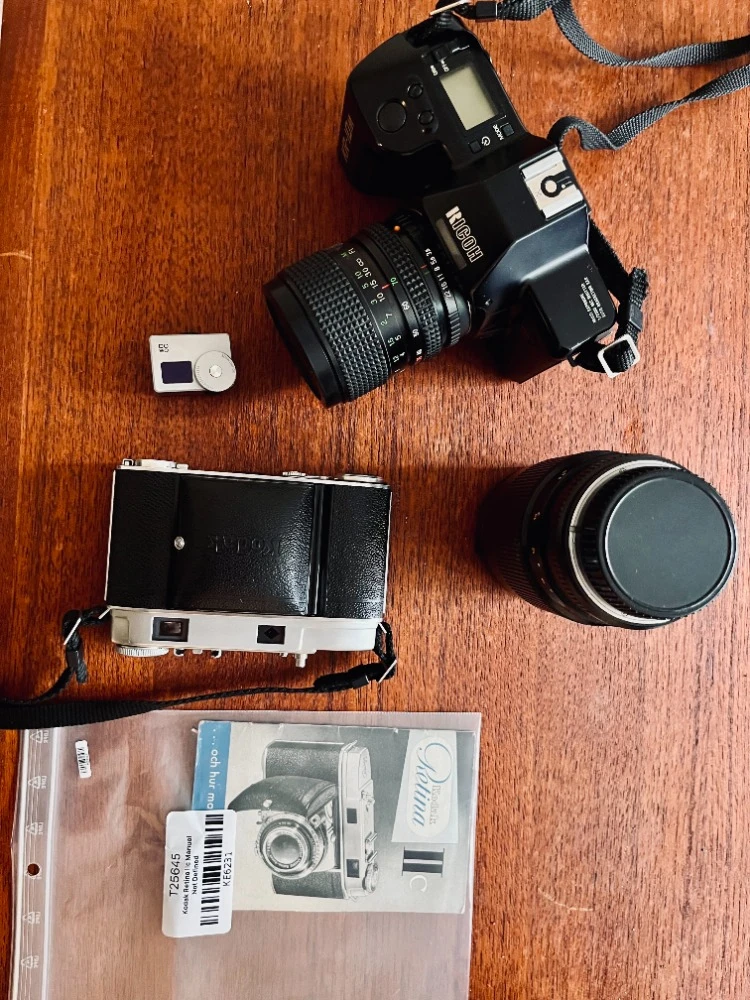
MAGNUS.TOWN
:
My Analogue Cameras
31 December, 2024
My Camera Collection
Here I’m presenting two of the analogue cameras I use: the Kodak Retina IIc and the Ricoh KR-10M.
Kodak Retina IIc
The Kodak Retina IIc is a fully manual, mechanical, beautiful, compact 35mm rangefinder camera with a folding design that’s both practical and elegant. It’s super portable and fits in my pocket, but it’s still full of personality.

Specs
- Lens: Rodenstock Retina-Heligon 50mm f/2.8
- Shutter: Synchro-Compur, with speeds from 1 second to 1/500th of a second as well as bulb mode.
What’s fascinating is that this camera was made by Germans right after World War II. It carries a sense ingenuity from that timeperiod. The Retina series was developed by Kodak AG, the German subsidiary of Eastman Kodak, which had acquired Nagel Camerawerk in Stuttgart in 1931. August Nagel, the founder of Nagel Camerawerk, played a crucial role in designing the Retina cameras and even introduced the 35mm film cartridge, which became a photography standard. I think it is really fascinating that a standard which is that old, still works and is available today.
Here’s where it gets even more interesting: before founding Nagel Camerawerk, August Nagel co-founded Contessa-Nettel AG, which later became part of Zeiss Ikon in 1926. Though Carl Zeiss, the founder of Zeiss, wasn’t directly connected to the Retina cameras, Nagel’s earlier association with Zeiss Ikon highlights the interconnected nature of the German camera industry at the time. Because of this, the Kodak Retina series is a bit similar to the more famous Zeiss Ikon series.
Shooting with this camera slows everything down because it is fully manual. It makes me think more about each shot instead of just snapping away. I feel more connected to the process, and that’s part of what makes using it so rewarding.
Why
It’s hard not to love this little gem. The fact that it still works so well after all these years is mind-blowing. And the photos? They have this timeless quality that’s hard to describe but easy to appreciate.
Ricoh KR-10M
Fast forward to 1990, and we have the Ricoh KR-10M. This single-lens reflex (SLR) 35mm camera offers a bit more automation and excellent images for a 35mm film stock.
Specs
- Lens Mount: Pentax K-Mount
- Shutter Speeds: 1 second to 1/1000th of a second
- Modes: Manual and aperture priority
The KR-10M was introduced by Ricoh in 1990 as a more electronically oriented alternative to their manual-focus K-mount cameras. It features motorized film advance and rewind, requiring four AA batteries housed within its grip. This design choice reflects the era's shift towards automation in photography, aiming to provide photographers with quicker shooting capabilities and ease of use. It also have the option to shoot 2FPS.
While it’s not as portable as the Retina IIc, one of the big reasons I keep coming back to the KR-10M is the 200mm lens I use with it. This lens gives me sharper images and lets me capture shots that the Retina simply can’t when the action is a bit further away.
Why
The KR-10M is tough - this thing is a tank. The 200mm lens adds another layer of versatility, making it my go-to for situations where I want a more detailed image and stay further away from the action.
Why I Love Shooting Film
I know digital cameras are faster and more convenient, but there’s something about film that keeps pulling me back. Shooting film forces me to slow down, select the scene and think about the image. Every shot feels intentional, and there’s this excitement of not knowing exactly how it’ll turn out until I develop it. It has learned me a lot about photography, light and exposure. Also, it is something magical about that specific moment in time being captured physically there in the negative, which I thing is amazing!